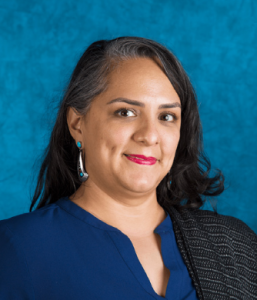A Pedagogy of Water: The Rio Grande/Rio Bravo as Ancestral Waters
by Marissa Aki’Nene Muñoz
At the beginning of the day the water was warm, and it was flowing smoothly, slowly. You know, you could bathe in it, and just walk into the water, and stay there. But once the sun started going down, you could see even the flow of the water was coming more rapidly, and the water was becoming mas fria, getting colder. And tambien del current and… la marea. The tide would start to get high, you know, during the day, you would stand in the middle of the water, and the water level would be just under your knees. And by maybe 6 o’clock or so, ya, it was up to about mid- thighs, aqui, más o menos. You would get out, because you could feel the current getting stronger.
You already knew, because our parents would tell you, “Te tienes que salir, porque el río es un traidor.” Tú lo ves and it’s flowing smoothly, tranquilito y todo, pero, you get in and get to a certain area, and it has undercurrents, and it pulls you. There is no way to stop from going with the current. So we knew, we were aware, and we took care of what we did. Y decían los adultos también: “¡Hey salte, salte!” “Aye, no, I’m having a good time.” There were a lot of kids at that time. Estábamos todos chiquitos so you know that not everybody would mind. Nosotros oíamos: “No se quiere salir Norma del río!” Y allá van—the grownups would go and get you outta there, because they knew. They knew more about the river than we did. (J. Ramirez, oral communication, February 2, 2016)
This story was shared by my great auntie, my gran Tia Cheffie, as four generations of women and girls from our family sat around the kitchen table, listening, laughing, and taking turns caring for my infant, Ofelia. It provides a beautiful example of how community members think and talk about the river, how the process of remembering calls forward other stories, and how concepts flow into each other within one conversation. The river, which flows almost 1,900 miles from Colorado to the Gulf of Mexico, is called Rio Grande in the US and Rio Bravo in Mexico.
 Marissa Aki’Nene Muñoz, PhD, is a Chicana with ancestry that includes Esto’k Gna, Coahuilteca, Tlaxcalteca, and Wixairika peoples, of what is today called South Texas and Northern Mexico. Muñoz is an assistant professor in the Department of Interdisciplinary Learning and Teaching with a joint appointment in the Department of Race, Ethnicity, Gender, and Sexuality Studies at the University of Texas at San Antonio. Muñoz draws from her experience as a middle-school teacher, museum educator, and curriculum developer to inform her ongoing research that documents the Indigenous knowledge systems of frontera communities with/along/of the Rio Grande/ Rio Bravo.
Marissa Aki’Nene Muñoz, PhD, is a Chicana with ancestry that includes Esto’k Gna, Coahuilteca, Tlaxcalteca, and Wixairika peoples, of what is today called South Texas and Northern Mexico. Muñoz is an assistant professor in the Department of Interdisciplinary Learning and Teaching with a joint appointment in the Department of Race, Ethnicity, Gender, and Sexuality Studies at the University of Texas at San Antonio. Muñoz draws from her experience as a middle-school teacher, museum educator, and curriculum developer to inform her ongoing research that documents the Indigenous knowledge systems of frontera communities with/along/of the Rio Grande/ Rio Bravo.